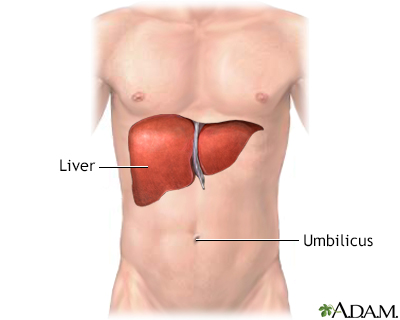Pregnancy SmartSiteTM
Fatty liver disease; Steatotic liver disease; Nonalcoholic steatohepatitis; NAFLD/NASH metabolic dysfunction-associated steatohepatitis; MASLD/MASH DefinitionNonalcoholic fatty liver disease (NAFLD) is the buildup of fat in the liver that is not caused by drinking too much alcohol. People who have it do not have a history of heavy drinking. NAFLD is usually but not always related to being overweight. For many people, NAFLD causes no symptoms or problems. A more severe form of the disease is called non-alcoholic steatohepatitis (NASH). NASH can cause cirrhosis and liver failure. It can also cause liver cancer. CausesNAFLD is the result of fat in the liver that is more than normal. Things that may put you at risk include any of the following:
Other risk factors may include:
NAFLD also occurs in people who have no known risk factors. SymptomsPeople with NAFLD often have no symptoms. When symptoms occur, the most common include:
In people with NASH who have liver damage (cirrhosis), symptoms may include:
Exams and TestsNAFLD is often found during routine blood tests that are used to see how well the liver is working. You may have the following tests to measure liver function:
Your health care provider may order certain imaging tests, including:
A liver biopsy may be needed to confirm a diagnosis of NASH, the more severe form of NAFLD. TreatmentThe treatment of NASH includes exercise, weight loss, lipid and glucose control. If you have evidence of scarring in the liver on the above testing, you may benefit from resmetirom (Rezdiffra), a recently approved drug to treat NASH. Resmetirom is a thyroid hormone receptor beta agonist, used in conjunction with diet and exercise, for the treatment of adults with noncirrhotic NASH with moderate to advanced liver fibrosis (consistent with stages F2 to F3 fibrosis). Your provider will help you understand your condition and the healthy choices that can help you take care of your liver. These may include:
Losing weight and managing diabetes can slow or sometimes reverse the deposit of fat in the liver. Outlook (Prognosis)Many people with NAFLD have no health problems and do not go on to develop NASH. Losing weight and making healthy lifestyle choices can help prevent more serious problems. It is unclear why some people develop NASH. NASH can lead to cirrhosis. When to Contact a Medical ProfessionalMost people with NAFLD do not know they have it. See your provider if you begin to have unusual symptoms such as fatigue or abdominal pain. PreventionTo help prevent NAFLD:
ReferencesChalasani NP, Maher J. Alcoholic and nonalcoholic steatohepatitis. In: Goldman L, Cooney KA, eds. Goldman-Cecil Medicine. 27th ed. Philadelphia, PA: Elsevier; 2024:chap 138. National Institute of Diabetes and Digestive and Kidney Diseases website. Eating, diet, and nutrition for NAFLD and NASH. www.niddk.nih.gov/health-information/liver-disease/nafld-nash/eating-diet-nutrition. Updated April 2021. Accessed May 23, 2025. Rinella ME, Neuschwander-Tetri BA, Siddiqui MS, et al. AASLD Practice Guidance on the clinical assessment and management of nonalcoholic fatty liver disease. Hepatology. 2023;77(5):1797-1835. PMID: 36727674 pubmed.ncbi.nlm.nih.gov/36727674/. Torres DM, Harrison SA. Nonalcoholic fatty liver disease. In: Feldman M, Friedman LS, Brandt LJ, eds. Sleisenger and Fordtran's Gastrointestinal and Liver Disease. 11th ed. Philadelphia, PA: Elsevier; 2021:chap 87. | ||
| ||
Review Date: 4/21/2025 Reviewed By: Todd Eisner, MD, Private practice specializing in Gastroenterology in Boca Raton and Delray Beach, Florida at Gastroenterology Consultants of Boca Raton. Affiliate Assistant Professor, Florida Atlantic University School of Medicine. Review provided by VeriMed Healthcare Network. Also reviewed by David C. Dugdale, MD, Medical Director, Brenda Conaway, Editorial Director, and the A.D.A.M. Editorial team. View References The information provided herein should not be used during any medical emergency or for the diagnosis or treatment of any medical condition. A licensed medical professional should be consulted for diagnosis and treatment of any and all medical conditions. Links to other sites are provided for information only -- they do not constitute endorsements of those other sites. No warranty of any kind, either expressed or implied, is made as to the accuracy, reliability, timeliness, or correctness of any translations made by a third-party service of the information provided herein into any other language. © 1997- A.D.A.M., a business unit of Ebix, Inc. Any duplication or distribution of the information contained herein is strictly prohibited. | ||


 Liver
Liver
